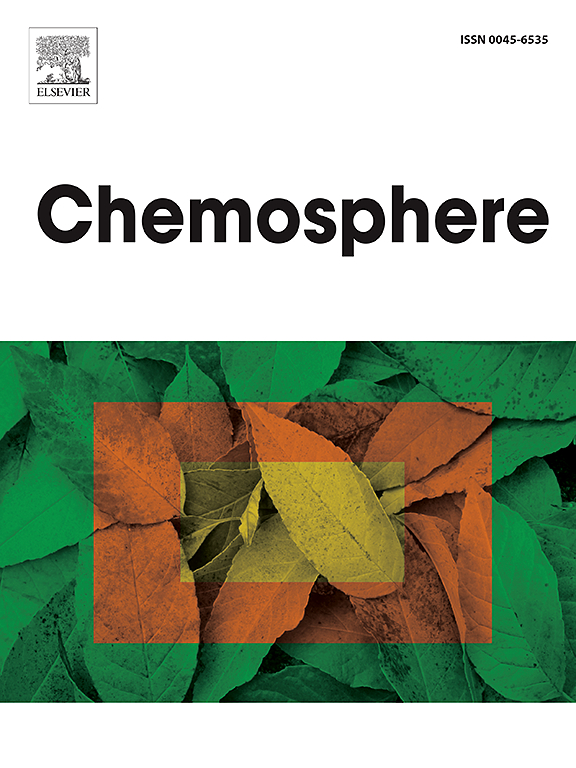锌氧空位和z型异质结光催化诺氟沙星降解产物的增效机理、随反应顺序的表观动力学及毒性研究
IF 8.1
2区 环境科学与生态学
Q1 ENVIRONMENTAL SCIENCES
引用次数: 0
摘要
本文构建了含锌氧双空位(VZn + O)的ZnCdS/ZnCr-LDHs Z-scheme异质结,并将其应用于光降解水中的诺氟沙星(NOR)。综合考察了复合材料中VZn浓度、催化剂用量、诺氟沙星浓度、溶液温度、pH值对降解活性的影响。全面研究了反应动力学,建立了完整的动力学方程,确定了活化能。系统分析了催化剂用量、pH、反应顺序等关键参数对反应过程的影响。从热力学和动力学的角度深入分析了NOR光降解的反应机理。z型异质结不仅有利于光生电荷的分离,还保留了具有强还原能力的光生电子和具有高氧化能力的光生空穴;双空位的存在不仅为材料提供了更多的活性位点,而且调节了材料的能带结构,有助于自由基的产生。在可见光照射90 min后,z型异质结与VZn + O的协同作用对浓度为20 mg/L的NOR的去除率达到89%。此外,基于ESR和XPS测试结果以及DFT计算,从能带结构、电子转移、自由基种类、内嵌电场等方面详细分析了z -图式异质结与VZn + O在光降解过程中的协同作用机理。并对NOR的光降解途径和中间产物的毒性进行了分析。本文章由计算机程序翻译,如有差异,请以英文原文为准。

Study on the synergistic mechanism, apparent kinetics with reaction order, and toxicity of degradation products of norfloxacin by zinc oxygen vacancies and Z-scheme heterojunction photocatalysis
In this paper, ZnCdS/ZnCr-LDHs Z-scheme heterojunction containing zinc-oxygen bi-vacancy (VZn + O) were constructed and applied to photodegradation of norfloxacin (NOR) in water. A comprehensive investigation was conducted into the effects of concentration of VZn in the composite, amount of catalyst, concentration of norfloxacin, temperature of the solution, and pH on the degradation activity. It comprehensively investigates the reaction kinetics, establishing a complete kinetic equation and determining the activation energy. Key parameters including catalyst dosage, pH, and reaction orders are systematically analyzed to elucidate their influence on the reaction process. The reaction mechanism of photodegradation of NOR is deeply analyzed from the perspectives of thermodynamics and kinetics. Z-scheme heterojunction not only facilitates the separation of photogenerated charges, but also preserves photogenerated electrons with strong reducing ability and photogenerated holes with high oxidizing ability; The existence of double vacancies not only provides more active sites for the material, but also regulates the band structure of the material, which contributes to the generation of free radicals. The synergistic effect of Z-scheme heterojunction and VZn + O resulted in a removal rate of 89 % for NOR with a concentration of 20 mg/L after 90 min of visible light irradiation. In addition, based on ESR and XPS test results as well as DFT calculations, the synergistic mechanism of Z-scheme heterojunction and VZn + O in the photodegradation process was analyzed in detail from the aspects of band structure, electron transfer, free radical species, and built-in electric field. The pathway of NOR photodegradation and the toxicity analysis of intermediate products were also provided.
求助全文
通过发布文献求助,成功后即可免费获取论文全文。
去求助
来源期刊

Chemosphere
环境科学-环境科学
CiteScore
15.80
自引率
8.00%
发文量
4975
审稿时长
3.4 months
期刊介绍:
Chemosphere, being an international multidisciplinary journal, is dedicated to publishing original communications and review articles on chemicals in the environment. The scope covers a wide range of topics, including the identification, quantification, behavior, fate, toxicology, treatment, and remediation of chemicals in the bio-, hydro-, litho-, and atmosphere, ensuring the broad dissemination of research in this field.
 求助内容:
求助内容: 应助结果提醒方式:
应助结果提醒方式:


